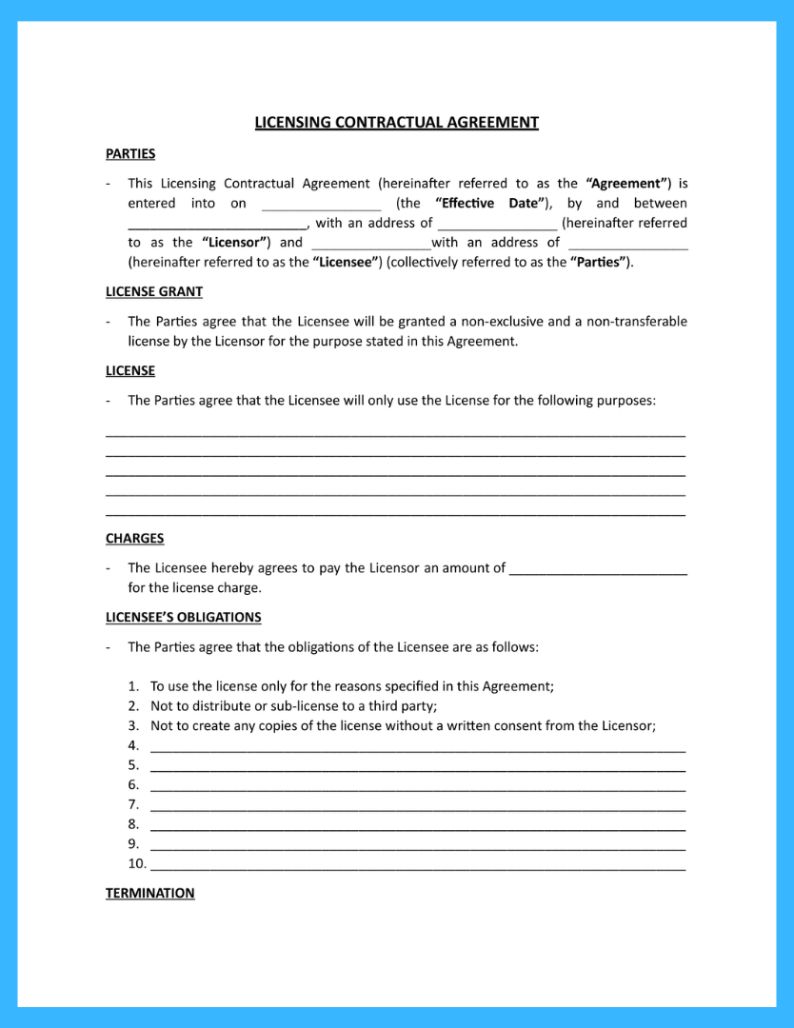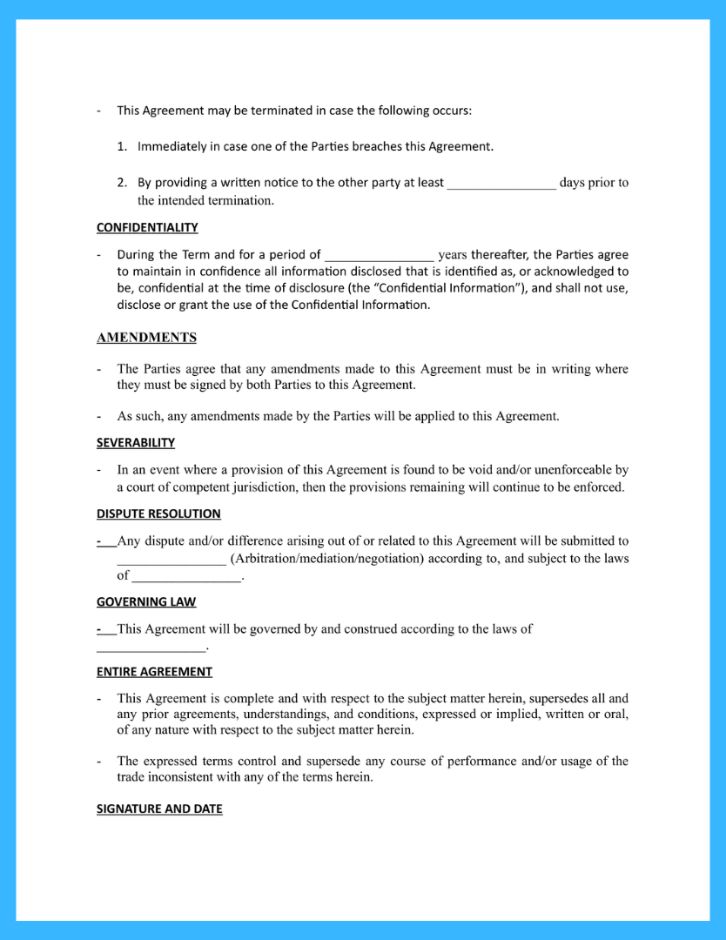Free Licensing Agreement Template to Use Today
Are you entering the complex realm of intellectual property and licensing? While it can seem like an uphill battle, there are resources you can take advantage of to come out on top.
Arm yourself with Signaturely’s easily accessible and user-friendly licensing agreement templates. Simplify the process, protect your interests, and grant licenses professionally. This article provides an overview of the ins and outs of licensing agreements.



What are Licensing Agreements?
Licensing agreements, also referred to as license agreements, are legal contracts between two parties – the licensor and the licensee. The licensor, often the property owner, grants the licensee permission to use particular intellectual property.
These permissions can include patents, trademarks, copyrights, or trade secrets, for a specified period under certain conditions. The agreement establishes the terms of use, payment details, and how the licensee can exploit the licensed property. Thus, it serves as a protective mechanism, ensuring a fair transaction that respects the rights of both parties involved.
Why Licensing Agreements Are Important
Licensing agreements play a vital role in facilitating business transactions involving intellectual property. Providing a legal framework significantly reduces direct or indirect conflict risks between the licensor and licensee.
These agreements help the licensor maintain control over their property, ensuring it’s not misused or devalued. On the other hand, the licensee receives prior written consent to use the licensed property, thereby preventing potential infringement issues.
Moreover, licensing agreements are crucial in outlining specific terms such as royalty payment, duration of use, and termination conditions. By clearly defining these, licensing agreements prevent misunderstandings, protect interests, and ultimately provide a significant competitive advantage in the business world.
DISCLAIMER: We are not lawyers or a law firm and we do not provide legal, business or tax advice. We recommend you consult a lawyer or other appropriate professional before using any templates or agreements from this website.
When to Use Licensing Agreement Templates
As the world pivots to digital, intellectual property takes center stage, and with it, proper licensing agreements are necessary. So, when exactly should one use licensing agreement templates?
For starters, if you’re a business owner or innovator with a valuable intellectual asset, licensing agreements are an absolute must when you permit another entity to use your assets. An agreement could be used when a company wants to manufacture a product using your patented technology or a songwriter wishes to give a music artist the right to perform their song.
Moreover, these license agreement templates are helpful when collaborating with another party. If you plan to use someone else’s copyrighted material or proprietary technology, licensing agreements can help delineate usage rules, protecting both parties from potential infringement or misuse.
Another instance could be a software developer granting licenses to users. The license agreement would outline the users’ rights, such as installation limits or restrictions on modification.
When granting or obtaining intellectual property rights, turn to licensing agreement templates. With Signaturely, these templates are just a few clicks away, simplifying the process and ensuring your intellectual assets are well protected.
What to Include in Licensing Agreements
While a licensing agreement can appear intricate and complex, it ultimately comes down to a few key elements that make it work. Crafting a comprehensive and effective agreement ensures that it truly becomes an instrument of protection for your intellectual property. Below are the crucial components you need to include when drafting a license agreement.
Licensor & Licensee Details
First and foremost, every license agreement should clearly define who the parties involved are – the licensor and the licensee. These details include both parties’ full legal names, physical addresses, and possibly contact information. Being precise leaves no room for ambiguity and provides a clear reference point for future communication or possible legal requirements.
In some cases, you may also want to mention the legal status of both parties, especially if they are business entities. For instance, if the licensor is a corporation, you should state the corporate name precisely as it appears in the official registration documents and the jurisdiction where the company is registered.
Purpose of Licensing
The purpose of licensing serves as the cornerstone of the entire license agreement. This section should include explicit details about why the license is being granted and what the licensee can do with the licensed property. Is it for a one-time use? Or is it to manufacture and sell products using patented technology?
The more precise you are in defining the purpose, the less room there is for misinterpretation. Furthermore, outlining these specifics can also prevent the licensee from engaging in activities outside the agreed scope, thereby providing additional protection for the licensor. Remember, broad and ambiguous terms can lead to complications down the line, so specificity is your best friend here.
Intellectual Property
This section is the heart of the matter – the intellectual property itself. It’s crucial to provide a detailed description of the licensed intellectual property. Whether it’s a trademark, patent, copyright, or trade secret, clarity here can prevent potential misuse or overstepping of boundaries by the licensee.
Make sure to describe your intellectual property in a way that leaves no room for doubt. If it’s a patent, provide the patent number and a comprehensive description of the technology. For copyrighted material, offer enough detail to identify the work. If it’s a trademark, mention the trademark registration number and the exact representation of the mark.
Moreover, if you’re licensing a bundle of intellectual property rights, it’s essential to list each individually and describe the associated rights. For instance, a software license may involve both copyright and trademark rights.
Fees & Payment Details
The payment structure is one of the most critical aspects of any license agreement. How will the licensor be compensated for granting the license? The agreement must state whether a flat fee, royalty payments, or another form of compensation will be used.
With royalty payments, specify the percentage and the calculation basis. Will it be a percentage of gross revenue, net profit, per unit sold, or another cause? Furthermore, how often will payments be made? Also, stipulate the preferred payment method and the consequences for late payments. Remember, the more precise the payment details, the smoother the business relationship.
Term of License
Another vital element is the term of the license, as this section outlines the agreement’s effective date and the duration of the license. These terms could be for a set period (e.g., five years), for the life of the intellectual property (such as the life of a patent), or until a specific event occurs.
Furthermore, consider whether the license will be renewable. If so, detail the renewal process, any conditions, and whether there are any limits on the number of times the license can be renewed.
Dispute Resolution & Termination
Next, you need to anticipate and plan for potential hiccups. Disputes are never desired, but being prepared can save you headaches later on. Specify the dispute resolution process – will you use arbitration, mediation, or court proceedings? What applicable law will govern the agreement?
In addition, your license agreement should outline the terms for termination. Under what circumstances can the license be terminated? What happens to the licensed intellectual property after termination?
Signatures
Finally, and most importantly, the license agreement needs to be signed by all parties to become legally binding. Without a signature, it’s merely a piece of paper.
This is where Signaturely can become your essential partner. With Signaturely, you can easily send, sign, and manage your licensing agreements online. It provides a secure, efficient, and legally binding way to get your contracts signed, eliminating the hassle of physical paperwork.
Download our free example
Licensing Agreement Template
We’ve got your back here at Signaturely, and we’re ready to help make stress-free agreements a reality. Forget the confusing paperwork and overwhelming legal jargon – get easy, breezy agreements templates for your customers in minutes with our free template.
How Do You Write Licensing Agreements?
Writing a license agreement doesn’t have to feel like a Herculean task. Begin by identifying the crucial elements to be covered, which we’ve already discussed in detail. Instead of starting from scratch, a licensing agreement template can be the most efficient and straightforward way forward. Licensing agreement templates provide a foundation, helping you structure your document and ensuring you don’t miss any critical sections.
A template should be a starting point — don’t be afraid to modify sections according to your circumstances. Each license agreement is unique, after all. Finally, always have a legal professional review your drafted agreement to ensure its validity and protect your interests.
FAQs About Licensing Agreement Templates
Below are some of the most frequently asked questions about licensing agreements.
How do I create a licensing agreement?
The journey to crafting a licensing agreement begins with a thoughtfully designed template. Customizing it according to your distinct requirements is a must, ensuring to encapsulate critical elements like the participants in the agreement, the objective behind the licensing, particulars of the intellectual property, and terms of payment.
What are typical license agreement terms?
Ordinarily, a licensing agreement delineates the licensor and the licensee, spells out the extent and objective of the license, stipulates fees and payment specifics, marks the lifespan of the license, and offers provisions for resolving disputes and terminating the agreement.
What is an example of a licensing agreement?
An example could be a software company granting a non-exclusive license to users to use their software. The agreement would detail the terms and conditions, including limitations on usage, fees, time, and termination.
What are the two types of licensing agreements?
Several licensing agreements are out there, but exclusive and non-exclusive licenses often rise to the top in terms of prevalence. An exclusive license grants the licensee sole usage rights of the licensed property. In contrast, a non-exclusive license enables the licensor to bestow licenses to numerous parties.
What You Need to Remember About Licensing Agreements Templates
While licensing agreement templates are a helpful starting point, remember to tailor them to suit your specific needs. Each licensing scenario is unique, and your agreement should reflect that. Always involve legal counsel to review and fine-tune your licensing agreement to ensure it’s comprehensive and legally sound.
Moreover, an e-signature solution like Signaturely can make the signing process more straightforward and legally binding. Keep in mind that a well-structured licensing agreement can provide a significant competitive advantage by protecting your interests and fostering successful business relationships.
Licensing Agreement Template
LICENSING CONTRACTUAL AGREEMENT
PARTIES
- This Licensing Contractual Agreement (hereinafter referred to as the “Agreement”) is entered into on ________________ (the “Effective Date”), by and between ________________________, with an address of ________________ (hereinafter referred to as the “Licensor”) and ________________with an address of ________________ (hereinafter referred to as the “Licensee”) (collectively referred to as the “Parties”).
LICENSE GRANT
- The Parties agree that the Licensee will be granted a non-exclusive and a non-transferable license by the Licensor for the purpose stated in this Agreement.
LICENSE
- The Parties agree that the Licensee will only use the License for the following purposes:
______________________________________________________________________________________________________________________________________________________________________________________________________________________________________________________________________________________________________________________________________________________________________________________________________
CHARGES
- The Licensee hereby agrees to pay the Licensor an amount of ________________________ for the license charge.
LICENSEE’S OBLIGATIONS
- The Parties agree that the obligations of the Licensee are as follows:
- To use the license only for the reasons specified in this Agreement;
- Not to distribute or sub-license to a third party;
- Not to create any copies of the license without a written consent from the Licensor;
- _________________________________________________________
- _________________________________________________________
- _________________________________________________________
- _________________________________________________________
- _________________________________________________________
- _________________________________________________________
- _________________________________________________________
TERMINATION
- This Agreement may be terminated in case the following occurs:
- Immediately in case one of the Parties breaches this Agreement.
- By providing a written notice to the other party at least ________________ days prior to the intended termination.
CONFIDENTIALITY
- During the Term and for a period of ________________ years thereafter, the Parties agree to maintain in confidence all information disclosed that is identified as, or acknowledged to be, confidential at the time of disclosure (the “Confidential Information”), and shall not use, disclose or grant the use of the Confidential Information.
AMENDMENTS
- The Parties agree that any amendments made to this Agreement must be in writing where they must be signed by both Parties to this Agreement.
- As such, any amendments made by the Parties will be applied to this Agreement.
SEVERABILITY
- In an event where a provision of this Agreement is found to be void and/or unenforceable by a court of competent jurisdiction, then the provisions remaining will continue to be enforced.
DISPUTE RESOLUTION
- Any dispute and/or difference arising out of or related to this Agreement will be submitted to ________________ (Arbitration/mediation/negotiation) according to, and subject to the laws of ________________.
GOVERNING LAW
- This Agreement will be governed by and construed according to the laws of ________________.
ENTIRE AGREEMENT
- This Agreement is complete and with respect to the subject matter herein, supersedes all and any prior agreements, understandings, and conditions, expressed or implied, written or oral, of any nature with respect to the subject matter herein.
- The expressed terms control and supersede any course of performance and/or usage of the trade inconsistent with any of the terms herein.
SIGNATURE AND DATE
- The Parties hereby agree to the terms and conditions set forth in this Agreement and such is demonstrated throughout their signatures below:
LICENSOR | LICENSEE _______________________________ |
DATE _______________________________ | DATE _______________________________ |
Download Our Free Licensing Agreement Template Today
Don’t waste any more time trying to craft the perfect licensing agreement. Our free licensing agreement template is ready and ready to download in one quick, convenient click—no more complicated documents for you or your clients to fill out. Just download, customize, and off you go!
Don’t wait – get your free licensing agreement template today and get geared up for business growth.